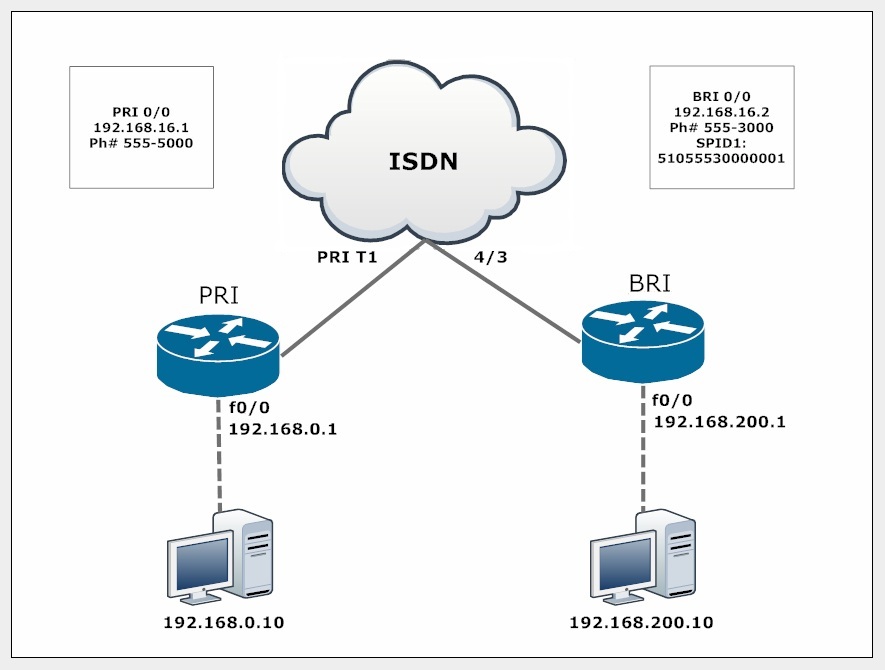ISDN WAN LAB
Lab ISDN Configuring ISDN PRI & BRI
Objective
In this lab you will configure a ISDN BRI on a remote site router and a ISDN PRI to a central site router.
Step 1
1. Basic Set up
- Cable the network according to the topology using the Adtran for the ISDN Cloud. You will need a router with a BRI and a T1 controller ask your instructor which devices these will be. Also you will need a DB-15 to RJ45 adapter and special cord to connect your devices (ask instructor). On the ISDN router use a straight through cable to ISDN port 3 on the Adtran.
- Clear all preexisting configurations from the devices.
- Set up your devices with a basic configuration including static routes to the remote networks. Make sure to set the hostnames of the routers to PRI-RTR and BRI-RTR.
Step 2
Configure the ISDN PRI connection with the following commands:
1. Configure the appropriate switch type The switch type can be configured globally or on the interface. Global configuration will set all ISDN interfaces to that switch type, where as configuring the switch type on an interface will affect only that interface.
- Router(config)#isdn switch-type primary-ni
To view information on switch types, see ISDN Switch Types.
2. Configure the T1 controller for the service provider's framing and linecode.
- Router(config)#controller T1 1/0
- Router(config-controller)#framing esf
- Router(config-controller)#linecode b8zs
- Router(config-controller)#pri-group timeslots 1-24
The range argument assigns the range of time slots that are allocated to the RRI. T1 has a range of time slots ranged 1 through 24.
4. Configure the D channel. With 24 channels being numbered from 0 to 23, the D channel is number 23.
- Router(config)#interface serial 1/0:23
- Router(config-if)#ip address 192.168.16.1 255.255.255.0
- Router(config-if)#encapsulation ppp
5. Set the Dialer Idle Timeout.
- Router(config-if)# dialer idle-timeout 60
The dialer idle timeout defaults to 120 seconds. You will need to change it to a lower value to avoid excessive call charges.
6. Configure dialer list to identify interesting traffic.
- Router(config)# access-list 1 permit any
- Router(config)# dialer-list 1 protocol ip list 1
7. Associate the interface to the already created dialer-list
- Router(config-if)# dialer-group 1
8. Configure the Dialer Map
- Router(config-if)# dialer map ip 192.168.16.2 name BRI-RTR 555-3000
The dialer map tells the interface what to do with interesting traffic
Step 3
Configure B Channel Aggregation There are two types of B channel aggregation available on Cisco routers. This document was written using Multilink PPP.
Cisco proprietary BOD uses a proprietary algorithm to calculate a load value and can only be applied outbound. Multilink PPP (MLP)uses a standards based algorithm and can be applied inbound, outbound, or either.
1. Configure the load threshold that will trigger the use of the second B channel.
- Router(config)#interface serial1/0:23
- Router(config-if)#dialer load-threshold 1 outbound
The load argument can be any value between 1 and 255 (A threshold of 50 percent would be expressed as 128). In the case of BOD, the directional keyword is not necessary as BOD can only be applied outbound.
- Router(config-if)#ppp multilink
This step is only necessary when using MLP.
Step 4
Configure Snapshot Routing
1. Configure a dynamic routing protocol.
2. Configure the snapshot server
- Router(config)#interface serial1/0:23
- Router(config-if)#snapshot server 5
the active-time argument is the amount of time in minutes that routing updates with be exchanged and must be the same between the server and the client. The dialer keyword is an option to allow the client to dial up the server if there is no "interesting" traffic.
Step 5
Configure the ISDN BRI connection with the following commands:
This document assumes that basic router configuration has already been completed.
1. Configure the router to use the appropriate ISDN switch types.
- Router(config)# isdn switch-type basic-ni
To view information on switch types, see ISDN Switch Types.
2. Configure dialer list to identify interesting traffic.
- Router(config)# access-list 1 permit any
- Router(config)# dialer-list 1 protocol ip list 1
3. Configure BRI interface.
- Router(config)# interface bri0/0
- Router(config-if)# ip address 192.168.16.2 255.255.255.0
- Router(config-if)# encapsulation ppp
4. Configure service profile identifiers (SPIDs).
- Router(config-if)# isdn spid1 51055530000001 5553000
- Router(config-if)# isdn spid2 51055530010001 5553001
5. Set the Dialer Idle Timeout.
- Router(config-if)# dialer idle-timeout 60
The dialer idle timeout defaults to 120 seconds. You will need to be changed to a lower value to avoid excessive call charges.
6. Associate the interface to the already created dialer-list
- Router(config-if)# dialer-group 1
7. Configure the Dialer Map
- Router(config-if)# dialer map ip 192.168.16.1 name PRI-RTR 5555000
The dialer map tells the interface what to do with interesting traffic You do not need to enable broadcasts if your routing protocol does not need broadcast. The dial string is the destination telephone number.
8. Configure load threshold
- Router(config-if)#dialer load-threshold 1 outbound
The load argument can be any value between 1 and 255 (A threshold of 50 percent would be expressed as 128).
Step 6
configure Snapshot Routing 1. Configure a dynamic routing protocol.
2. Configure the snapshot client.
- Router(config-if)#snapshot client 5 8
The quiet-time argument, like the active-time argument, is expressed in minutes and is generally equivalent to the active-time x3. The suppress-statechange-updates option will prevent needless triggered updates in such situations as a line protocol changing states.
- Router(config-if)#dialer map snapshot 1 5555000
This command identifies which router to call as the snapshot server. The sequence-number identifies the order in which that server is called in cases where there may be more than one snapshot server. Setting it to 1 would make it the first server to call. The dial-string is the destination snapshot server telephone number.
Step 7
CLEAN UP!
Additional Resources
Need Help understanding how this lab works? Check out these sites:
- Configuring Channelized T1 ISDN PRI - This is what you're doing on the PRI router.
